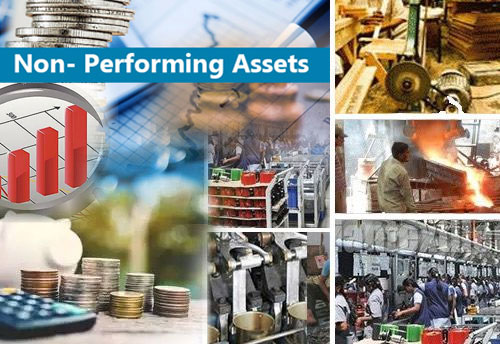NPAs in MSME sector to increase again: Survey
Updated: Mar 18, 2021 06:46:06am

NPAs in MSME sector to increase again: Survey
New Delhi, Mar 18 (KNN) Non Performing Assets (NPAs) in the Micro, Small and Medium Enterprises (MSME) could rise once again, revealed the twelfth round of the FICCI-IBA Survey.
The survey which was carried out for the period July to December 2020 saw a participation of total of 20 banks including public sector, private sector and foreign banks
According to the survey, some of the high NPA risk sectors identified by majority of respondent bankers in current round of survey include Tourism and hospitality, MSME, Aviation and Restaurants. 55 per cent of respondents believe NPAs to rise substantially in tourism and hospitality sector, while another 45 per cent reported that NPAs are likely to increase moderately in this sector.
''Another high NPA risk sector reported in the current round of survey is the MSME sector, with 84 per cent respondents expecting an increase in NPAs in this sector. Almost 89 per cent respondents also expect Restaurants to see an increase in NPAs, though only 26 per cent expect NPAs to increase substantially in this segment,'' the survey stated.
According to the survey, almost a year into the pandemic, economic recovery has started to gain momentum. High-frequency indicators show demand is holding up. The bank credit is also seeing improvement, as indicated by RBI’s statistics.
The survey findings also show that long term credit demand has been growing for sectors such as Infrastructure, Pharmaceuticals and Food Processing. Particularly for the pharma sector, 45 per cent of the respondents have indicated an increase in long term loans in the current round of survey as against 29 per cent in the previous round. Better sectoral growth prospects have helped the credit uptake in these sectors. Infrastructure and
''Pharmaceuticals are expected to see an increase in long term credit even in the first half of 2021, as reported by 68 per cent and 58 per cent of respondents, respectively. Other sectors expected to see a rise in long term credit include Metals, Iron & steel, Automobiles, Real estate and NBFCs,'' it said.
The survey further states that the number of banks reporting tightening of credit standards during the second half of 2020 has come down. 47 per cent of respondent banks reported tightening of credit standards for large enterprises as against 68 per cent in the last round. Likewise, the percentage of banks reporting tightening of credit standards for SMEs has come down to 21 per cent from 44 per cent in the last round. In-fact, there has been a significant increase in respondents that have eased credit standards for SMEs, from 28 per cent in the previous round to 53 per cent in the current round.
The reasons cited for easing of credit standards are expectations of better growth going forward, reduction in their cost of funds and the need for providing COVID-19 relief to borrowers. The credit standards are likely to remain unchanged in the first half of 2021, as reported by a large majority of respondent bankers.
Participating bankers in the survey were also asked to share insights on the sectoral deployment of funds availed under on-tap targeted long-term repo operations (TLTRO) scheme, which was announced by the RBI to provide more liquidity in the system. Over half of the respondents indicated not having availed funds under TLTRO while about 33 per cent indicated that TLTRO funds were deployed completely in securities issued by NBFCs/ MFIs.
RBI in its second bi-monthly policy meeting on August 6, 2020 had also extended the provision of one-time restructuring scheme for MSMEs, keeping in view the need to provide COVID-19 relief. The current round of survey reveals that there has been a significant increase in the request for restructuring of advances. An overwhelming 85 per cent of the respondent banks have cited an increase in requests for restructuring of advances as against 39 per cent in the last round.
The NPA levels for second half of 2020 have seen an improvement, with 50 per cent of respondent banks reporting a decline in NPAs during the current round of survey. Bank wise analysis reveals that major improvement in NPAs has come from the PSBs. About 78 per cent of participating Public sector Banks (PSBs) have cited a reduction in NPA levels. This can be attributed to an improvement in asset quality, especially with improved recoveries and higher write-offs by several banks. Moreover, due to COVID-19 pandemic, the Supreme Court (SC) had ordered all banks not to classify COVID-19 related defaults as NPAs. Amongst the sectors that continue to show a high level of NPAs, most of the participating bankers identified sectors such as Infrastructure, Metals, iron & steel, Real Estate and Engineering Goods.
However, in terms of outlook, nearly 68 per cent of respondent bankers expect the NPA levels to be above 10 per cent in the first half of 2021. 37 per cent of respondents’ in-fact expect NPA levels to be upwards of 12 per cent. In the RBI Financial Stability Report, which was released in January 2021, under stress test under baseline scenario, GNPA could go up to 13.5 per cent by September 2021.
Banks were asked to suggest key measures for faster return to normalisation and acceleration of growth thereafter. The recommendations included direct cash transfers to economically weaker sections in rural India, rationalizing personal income tax rates, raising the minimum wages of the low-income workers.
Bankers also suggested increased focus on enhancing indigenous manufacturing capacity, extending PLI scheme to the Manufacturing, Service and Export sectors, reducing the number of GST rate slabs and rationalizing of rates. Amongst the banking related measures, the surveyed respondents had asked for recapitalisation of banks which has also been announced in the Union Budget.
Other suggestions included extension of ECLGS scheme till Q1 FY22 and relaxing the NPA classification norms to 180 days.












